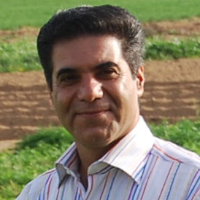Mapping forest distribution and density as well as other land uses in Arasbaran area using Sentinel2 data
Nowadays, natural resources are exploited for the purpose of economical development in developing countries. Expansion of agricultural lands, supply of charcoal and fuel wood and wood production play an important role in forest degradation which affects biodiversity, soil conservation, the quantity and quality of water and the global climate conducted to the importance of forest conservation and reforestation. Therefore quantitative assessment of forests is required for conservation programs and forest monitoring is defined as a tool for sustainable forest management.Today, remote sensing techniques and satellite images can widely provide functional information in environmental studies. In this work, sentinel-2 satellite images with high spatial, temporal and spectral resolution were applied to determine the area, distribution and density of the Arasbaran forestsas well as other land use classes in the area.
Arasbaran area is located in Qaradagh mountainous region inthe north of East Azerbaijan province between 38°25′ 59 " N- 39°20′ 7.7 " N latitude and 46°09′ 18 " E- 47°16′ 5.3 " E longitude which covers an area of 551211 hectares and the deciduous forests of this area are known as the 11th Biosphere Reserved in Iran. The altitude varies from ca. 256 m tomore than 2000 m. the importance of the area is in having a rich flora (about 1334plant species) and unique vegetation among the vegetation of the country.
For the first time, the Sentinel-2 images with a combination of high spatial and temporal resolution were used to classify the land use of the area.The best band combination was found for bands 2, 3, 6, 12 and NDVI index. Land use classification included dense, semi -dense, sparse and very sparse forests as well as rangeland, agriculture, residential area-bare soil, garden and water was implemented using 9 different algorithms in a pilot area to find the best algorithm. 280 training sample points were collected from all different land use classes in the area.Consequently, supervised classification technique and Maximum Likelihood algorithm with the Kappa coefficient of 0.886 and anoverall accuracy of 89.6% was identified as the best classification method for the Arasbaran area.Accuracy assessment of the final map was done using ground control points and Google earth images with a total accuracy of 95%.Finally creating an error matrix with 880 ground reference test pixels revealed the accuracy indices.
The final land use map of the Arasbaran area based onthe Supervisedclassification technique and Maximum Likelihood algorithm was created.Based on the results, the accuracy assessment of the final map showed that the Kappa coefficient and the overall accuracy of the classified map were 0.88 and 89.8% respectively.The forest distribution and canopy cover density map were extracted from the land use area map. The total area of forests with a canopy cover of more than 5%, obtained 131019 ha consisting of 39% dense forest, 36% semi -dense forest, 17% sparse forest and 8% very sparse forest. In addition, the largest type of land use accounted for rangeland with 270000, forest with 131019, agriculture with 101974, residential area-bare soil with 30028, garden with 15434 and water with 2756 hectares respectively. Based on the error matrix table and correct classified points as well as total ground control points, the highest user’s and producer’s accuracy belonged to the densed forest class as well as the lowest user’s accuracy and lowest producer’s accuracy belonged to garden and agriculture classes respectively.
The results conducted supervised pixel-based image classification based on the Maximum Likelihood algorithms an acceptable method. It can be because of well -distributed training sample points, the high spatial resolution of sentinel-2 images or Environmental heterogeneity of the area. According to the results, dense forests declined(from 56910 to 50628 ha)however semi -dense and sparse forests have increased (from 35280 to 47930 ha)with respect tothe last forest survey project in the Arasbaran area in 2003.In addition, the results revealed an overlap between agriculture and garden as well as rangeland and residential area-bare soil classes because of multi culture of crops and fruit trees together as well as dried or low vegetation cover of rangelands in the area. These results can provide useful information for decision- making and sustainable forest management for reducing forest degradation and it seems to be an important next step to manage these forests based on conservation policies.
-
Estimation of susceptible land area for wood farming in non-forest lands of Guilan province
Fatemeh Ahmadloo *, Ali-Reza Rezaei, Mohsen Calagari, Saeedeh Eskandari, Sara Teimori, Fatemeh Dargahiyan, Mehdi Farahpour,
Iran Nature, -
Assessing the distribution of poplar plantations in Ardabil province
Younes Rostamikia *, , Mohsen Calagari, Reza Talaei, Bayramali Beyrami
Iran Nature, -
Investigation the preference value of the some speciesIn Sahand rangelands of East Azarbaijan province
MohammadReza Najibzadeh *, Mina Bayat, MohammadHasan Pezeshki, Mohammad Fayyaz
Iranian Journal of Range and Desert Research, -
Different approaches to determine the suitability of rangelands for medicinal plants exploitation (Case study: Mountain rangeland of Arshad Chaman, Sahand, East Azarbaijan)
M.H. Pezeshki, J. Motamedi *, A. Alijanpour, M. Souri, M.R. Najibzadeh, H. Arzani
Iranian Journal of Medical and Aromatic Plants,



